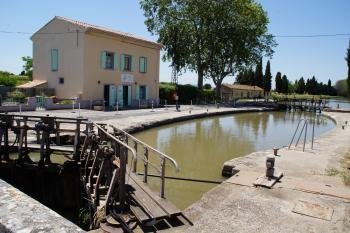
How to visit a canal of more than 240 kilometres in length - indeed a good question. The classical way is to navigate the canal by boat. But that would take several days, and I'm afraid it might be a bit boring after a while. Another option: by bicycle on the old towpath along the canal. Would be more appealing to me, but it would also take a few days to see a substantial part of the entire stretch. So we decided to visit the Canal du Midi by car on our trip from Arles via Carcassonne to Toulouse. After a bit search in the web I identified some structures that seemed to be the most interesting, and thanks to my tom-tom it was easy to find them.
First we headed for the round lock at Agde, a basin with three gates that connects the canal with the Hérault River. Next we went to the Ouvrages du Libron, a complex system of gates and walls to protect the Canal du Midi from an overflow of the river Libron at high water. Normally, the levels of the two streams are very similar, so that a conventional aqueduct was not applicable. The construction is a jumble of slide gates, ring gears, bars and chains. The principle is that the river is split in two streams, which cross the canal through separate aqueducts. By closing the gates successively a boat can safely navigate through the section. There are explanatory panels, but I'm not sure if I understood all the technical details. It would be interesting to see how the facility operates at high water.
The massive Orb Aqueduct in Béziers is a later addition, it was built in the 19th century and is the longest bridge on the Canal du Midi (240 metres). In Béziers is also the steepest section and the most spectacular place on the Canal du Midi, the Fonserannes Locks. With eight successive chambers and nine lock gates a boat can be lifted a height of 21 metres at a distance of 300 metres. It was fun to watch how a hobby skipper finally managed to steer his boat through all the lock chambers. From step to step it worked better - learning by doing with success. And all under the eyes of about 50 spectators which gave good advice.
A few other places where we had a short stop:
Malpas tunnel, the first navigable canal tunnel in Europe; Le Somail, a picturesque hamlet, once a stop for mail ships, some buildings, a chapel and an old stone bridge have been preserved; The Argent-Double Aqueduct, also an overflow to the Argent-Double river; a triple lock and the Orbiel Aqueduct in Trèbes.
The photo shows the lock in Homps where we had a sumptuous picnic. It is a typical place at the Canal du Midi, the technical facilities of the lock seem unchanged and also the lock keeper's house has been preserved. As with all locks on the canal, the chamber is oval, the curved walls better withstand the water pressure. This was one of the great technical innovations by Pierre-Paul Riquet, the engineer of the canal.
We stayed in Carcassonne, and the next day we went to the Bassin de Saint-Ferréol, the main water reservoir of the Canal du Midi. A major problem was to supply the canal with sufficient water throughout the year. The idea was to collect the water from the rivers of the Montagne Noir in a large reservoir. From there a canal, the Rigole de la plaine, feed the Canal du Midi at its highest point at the Col de Naurouze. Today, the construction is not very impressive, but in the 17th century the dam in Saint-Ferréol was the highest in the world. But to be honest, our main goal was not the dam but the nearby town of Revel, every Saturday there is a wonderful market in and around a medieval market hall. We also visited Castelnaudary, the highest point of the canal at Col de Naurouze, and the junction with the Garonne in Toulouse.
We enjoyed very much our trip along the Canal du Midi. It was a calm and peaceful atmosphere, the time seemed to pass more slowly than elsewhere. During the two days, we saw only about a dozen boats, but the ports were full of boats, suggesting that the canal may be quite crowded in high season. The structures and technical facilities might not be very impressive for today's visitors. But one have to take into account that most of the constructions date from the 17th century and were built with rather simple equipment. Riquet and his engineers had to find innovative solutions for the water supply, the flood protection, the rivers that cross the canal, etc. The Canal du Midi is a masterpiece of civil engineering - and it works until today.
More on
Comments
No comments yet.
